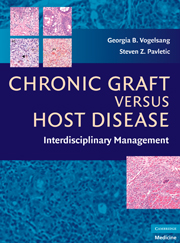Book contents
- Frontmatter
- Contents
- List of Contributors
- Preface
- PART I GENERAL PRINCIPLES
- PART II CLINICAL MANAGEMENT
- PART III ORGAN SITE OR SYSTEM-SPECIFIC MANIFESTATIONS
- 16 Cutaneous Manifestations of Chronic Graft versus Host Disease
- 17 Oral Chronic Graft versus Host Disease
- 18 Chronic Ocular Graft versus Host Disease
- 19 Gynecological Manifestations of Chronic Graft versus Host Disease
- 20 Gastrointestinal and Hepatic Manifestations of Chronic Graft versus Host Disease
- 21 Chronic Graft versus Host Disease and the Lung
- 22 Hematologic Complications of Chronic Graft versus Host Disease
- 23 Neurological Manifestations of Chronic Graft versus Host Disease
- 24 Rehabilitation Evaluation and Treatment of Patients with Chronic Graft versus Host Disease
- 25 Infections
- 26 Endocrine and Metabolic Effects of Chronic Graft versus Host Disease
- 27 Other Manifestations of Chronic Graft versus Host Disease
- 28 Psychosocial Issues in Chronic Graft versus Host Disease
- 29 Secondary Malignancies and Other Late Effects
- 30 Health-Related Quality of Life (HRQOL) in Chronic Graft versus Host Disease
- PART IV SPECIAL CONSIDERATIONS IN CHRONIC GVHD
- Index
- Plate section
29 - Secondary Malignancies and Other Late Effects
from PART III - ORGAN SITE OR SYSTEM-SPECIFIC MANIFESTATIONS
Published online by Cambridge University Press: 26 August 2009
- Frontmatter
- Contents
- List of Contributors
- Preface
- PART I GENERAL PRINCIPLES
- PART II CLINICAL MANAGEMENT
- PART III ORGAN SITE OR SYSTEM-SPECIFIC MANIFESTATIONS
- 16 Cutaneous Manifestations of Chronic Graft versus Host Disease
- 17 Oral Chronic Graft versus Host Disease
- 18 Chronic Ocular Graft versus Host Disease
- 19 Gynecological Manifestations of Chronic Graft versus Host Disease
- 20 Gastrointestinal and Hepatic Manifestations of Chronic Graft versus Host Disease
- 21 Chronic Graft versus Host Disease and the Lung
- 22 Hematologic Complications of Chronic Graft versus Host Disease
- 23 Neurological Manifestations of Chronic Graft versus Host Disease
- 24 Rehabilitation Evaluation and Treatment of Patients with Chronic Graft versus Host Disease
- 25 Infections
- 26 Endocrine and Metabolic Effects of Chronic Graft versus Host Disease
- 27 Other Manifestations of Chronic Graft versus Host Disease
- 28 Psychosocial Issues in Chronic Graft versus Host Disease
- 29 Secondary Malignancies and Other Late Effects
- 30 Health-Related Quality of Life (HRQOL) in Chronic Graft versus Host Disease
- PART IV SPECIAL CONSIDERATIONS IN CHRONIC GVHD
- Index
- Plate section
Summary
Large numbers of patients now survive long term following hematopoietic stem cell transplantation (SCT), and late clinical effects of SCT are, thus, of major concern. Chronic graft versus host disease (cGVHD) and the associated immunodeficiency are the primary causes of transplant-related mortality late after allogeneic SCT and contribute directly or indirectly to most late complications. Despite the advent of new treatment modalities the incidence of cGVHD has remained high, related to several changes in clinical SCT practice (1) the expanded use of human leukocyte antigen (HLA) matched unrelated and HLA nonidentical related donors; (2) the increasing use of SCT in older patients; (3) the increasing use of viable donor lymphocyte infusions after SCT to treat relapsed disease or to achieve full donor chimerism after nonmyeloablative transplantation; (4) the increasing use of peripheral blood stem cells instead of bone marrow as a source of stem cells. In addition to cGVHD and its therapy, the major risk factor for late complications after SCT is the use of irradiation in the pretransplant conditioning regimen. The interrelationship between cGVHD, total-body irradiation (TBI), and nonmalignant late effects are summarized in Figures 29.1 and 29.2.
Secondary malignant diseases are of particular clinical concern as more patients survive the early phase after SCT and remain free of their original disease.
Nonmalignant late effects are heterogeneous, and although often non-life threatening, they significantly impair the quality of life of long-term survivors.
- Type
- Chapter
- Information
- Chronic Graft Versus Host DiseaseInterdisciplinary Management, pp. 326 - 334Publisher: Cambridge University PressPrint publication year: 2009



